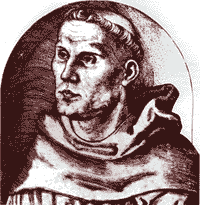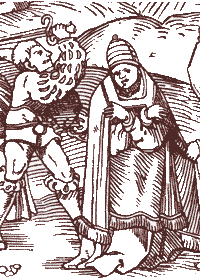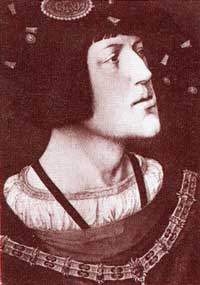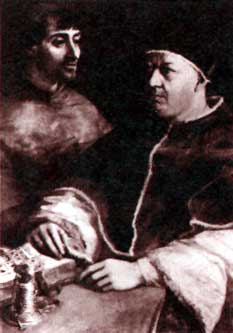|
Loading
|
|
|
| 1483 | Luther born, Eisleben, Germany. |
| 1505 | Luther makes his first entry to the monastery of the Augustinian Eremites in Erfurt. |
| 1511 | Luther made Doctor of Sacred Scriptures. |
| 1515-16 | Luther lectures at the University of Wittenberg on St Paul's Epistle to the Romans, discovering there the doctrine of justification by faith alone which was to set him at loggerheads with the Catholic Church. |
| 1517 | Luther's 95 Theses challenge the papal indulgence preached by Tetzel. |
| 1518 | Luther, summoned by Cajetan, refuses to retract his dissident views. |
| 1519 | Luther debates with the Catholic disputant Eck at Leipzig. |
| 1520 | Luther excommunicated by Leo X. |
| 1521 | Luther, outlawed by the Diet of Worms, takes up residence in the Wartburg Castle and begins to translate the Bible into German. |
| 1519 | Huldrych Zwingli begins preaching in Zurich, leading to Reformation in Switzerland from the 1520s. |
| 1522 | Luther publishes the New Testament in German. |
| 1525 | Zwingli suppresses the Catholic Mass in Zurich. |
| Luther marries the ex-nun Katharina von Bora. | |
| 1526 | Luther publishes a new German prayer service. |
| 1527 | Lutheran Reformation advances in Denmark and Sweden. |
| 1530 | The Lutheran Confession of Augsburg signed by German Protestant rulers. |
| 1536 | Calvin publishes his Protestant doctrinal compendium, the Institutes of Christian Religion. |
| 1540 | Pope Paul III licenses the new Catholic religious order, the Society of Jesus (Jesuits). |
| 1541 | Calvin established in the religious leadership of Geneva. |
| 1545 | (-1563) The Catholic Church's reforming Council of Trent assembles. |
| 1546 | Death of Luther in Eisleben. |
Luther's Reformation
by Michael Mullett
Dr Michael Mullett is Senior Lecturer in History at the University of Lancaster. The most recent of his several books on religious history are Catholics in Britain and Ireland, 1559-1829 (Macmillan, 1998) and The Catholic Reformation (Routledge, 1999). He is currently preparing a new study of Martin Luther, again for Routledge.
 The
roots of the Protestant Reformation as a great theological revolution can be seen
in Luther's failure in the years following 1506 to achieve his religious purpose
in entering the monastery — saving his soul from everlasting and horrifying damnation
and achieving eternal bliss through the strict observance of his vows as a monk.
The route chosen pre-supposed that people were made acceptable in God's sight through
their own "good works". After intense anguish and despair over trying and, he believed,
failing, to win God's favour through his own earnest endeavours as a monk, Luther
was to find, instead, through patient study of the Scriptures (above all St Paul's
Epistle to the Romans), that sinners such as he were exonerated by
God in recognition of His Son Christ's sacrifice on Calvary. Their faith was sufficient
so that people were "justified" or made righteous in God's eyes by faith alone,
without good works. It was a discovery that blasted the traditional Catholic way
of winning God's grace by one's own good works aided by the Church, and thereby
provoked a division in western Christianity that has endured to this day.
The
roots of the Protestant Reformation as a great theological revolution can be seen
in Luther's failure in the years following 1506 to achieve his religious purpose
in entering the monastery — saving his soul from everlasting and horrifying damnation
and achieving eternal bliss through the strict observance of his vows as a monk.
The route chosen pre-supposed that people were made acceptable in God's sight through
their own "good works". After intense anguish and despair over trying and, he believed,
failing, to win God's favour through his own earnest endeavours as a monk, Luther
was to find, instead, through patient study of the Scriptures (above all St Paul's
Epistle to the Romans), that sinners such as he were exonerated by
God in recognition of His Son Christ's sacrifice on Calvary. Their faith was sufficient
so that people were "justified" or made righteous in God's eyes by faith alone,
without good works. It was a discovery that blasted the traditional Catholic way
of winning God's grace by one's own good works aided by the Church, and thereby
provoked a division in western Christianity that has endured to this day.
 In
Luther's own time a simmering social discontent in Germany fostered the take-up
of his religious message. The great majority of Germans belonged to the peasant
class, into which Luther's own father Hans was born. It is difficult to generalise
about the actual living conditions of this vast category of people. Some were undoubtedly
prospering, and Hans Luther did well as a mining entrepreneur. However, population
increase from the second half of the fifteenth century onwards was putting pressure
on many peasant farmers, and noble and princely landlords were quick to exploit
the peasants' land-hunger by raising rents, dues and taxes. The result, especially
from the beginning of the sixteenth century onwards, was the emergence of underground
peasant militant organisations, in particular the Bundschuh, which organised
regional peasant risings. Then in the mid-1520s the German peasants rose in a great
revolt, the Peasants' War.
In
Luther's own time a simmering social discontent in Germany fostered the take-up
of his religious message. The great majority of Germans belonged to the peasant
class, into which Luther's own father Hans was born. It is difficult to generalise
about the actual living conditions of this vast category of people. Some were undoubtedly
prospering, and Hans Luther did well as a mining entrepreneur. However, population
increase from the second half of the fifteenth century onwards was putting pressure
on many peasant farmers, and noble and princely landlords were quick to exploit
the peasants' land-hunger by raising rents, dues and taxes. The result, especially
from the beginning of the sixteenth century onwards, was the emergence of underground
peasant militant organisations, in particular the Bundschuh, which organised
regional peasant risings. Then in the mid-1520s the German peasants rose in a great
revolt, the Peasants' War.
That rising was part of a social ferment in Luther's Germany that also took in classes such as the imperial knights. These were minor nobles, including the scholar knight Ulrich von Hutten (1488-1523) and his associate, the Luther supporter Franz von Sickingen (1481-1523). The knights, frequently impoverished, full of wide-ranging resentment and angrily anticlerical, mounted a serious rising against the German Catholic Church in 1522. The colourful maverick knight Götz von Berlichingen (1480-1562) even led a force of the rebel peasants in the revolt of 1525. Meanwhile Germany's great towns and cities, such as Nuremberg and Augsburg, were prey to class conflict, especially between working artisans and the upper middle class patrician elements who often controlled city governments. The actual situation in Germany's large number of self-governed cities varied enormously. While in cities such as Strasburg, the initiative in taking up Luther's emergent movement was seized by working people, it has been claimed that in Nuremberg, for example, the ruling patrician group maintained and enhanced their social and political control of the city through securing in the 1520s the adoption of Luther's cause as the city's official faith.
The process of urban Reformation would be recognised by some historians as a class victory of elite merchants and industrialists over the lower orders, and the further entrenchment of the Princes.
 Luther's
Germany was thus in many ways a divided society. Its political institutions were
decentralised and the country was split between princely states that were in effect
independent of the country's official leader, the Holy Roman Emperor, who was, for
most of Luther's lifetime, Charles V (reigned 1519-1555).
Luther's
Germany was thus in many ways a divided society. Its political institutions were
decentralised and the country was split between princely states that were in effect
independent of the country's official leader, the Holy Roman Emperor, who was, for
most of Luther's lifetime, Charles V (reigned 1519-1555).
 Such
political divisions were intensified by Luther's religious Reformation. Luther initially
hoped to maintain the unity of a reformed Catholic Church. He was, however, excommunicated
from the Church by Pope Leo X in 1520 and made an outlaw of the Holy Roman Empire
at the national assembly known as the Diet, meeting in the Rhineland city of Worms
in 1521. His message brought discord and conflict because it did not carry with
it the whole of his country, even though key autonomous German states, such as the
territory where Luther lived, electoral Saxony, adopted his Reformation. Eventually,
fear of a Catholic backlash led by the unswervingly Catholic Charles V, persuaded
these states, as well as independent city-states that adopted Luther's religious
message, to found a defensive league in 1531. In 1546 Europe's first war of religion
consequent on Luther's Protestant Reformation broke out in Germany, lasting until
a treaty in 1555 recognised stalemate and division.
Such
political divisions were intensified by Luther's religious Reformation. Luther initially
hoped to maintain the unity of a reformed Catholic Church. He was, however, excommunicated
from the Church by Pope Leo X in 1520 and made an outlaw of the Holy Roman Empire
at the national assembly known as the Diet, meeting in the Rhineland city of Worms
in 1521. His message brought discord and conflict because it did not carry with
it the whole of his country, even though key autonomous German states, such as the
territory where Luther lived, electoral Saxony, adopted his Reformation. Eventually,
fear of a Catholic backlash led by the unswervingly Catholic Charles V, persuaded
these states, as well as independent city-states that adopted Luther's religious
message, to found a defensive league in 1531. In 1546 Europe's first war of religion
consequent on Luther's Protestant Reformation broke out in Germany, lasting until
a treaty in 1555 recognised stalemate and division.
The Reformation's legacy
War and division were not the only consequences of the Protestant Reformation that Luther launched. Some writers take the view that Protestant Reformation ideals, in the hands of religious reformers including the Frenchman John Calvin (1509-1564), created a puritan ethic of work and thrift which have helped generate economic progress and, specifically, stimulate capitalism. At the same time, the Protestant Reformation fathered by Luther stimulated a deep religious spirituality in Protestant countries including Germany, the Scandinavian lands, England, Scotland and the Netherlands, and produced great Protestant-inspired literature in the hands of poets such as the Englishman John Milton (1608-1674). Indeed, it may have been the case that Protestantism, which was concerned with texts, and above all with the Bible, placed a new emphasis on the written (and printed) word, while at the same time, it dis-valued the pictorial image. Certainly the Reformation in England and Scotland saw a terrible iconoclastic destruction of a rich artistic legacy or religious iconography.
|
|
|
|
|
Milton's lifetime saw much of the legacy of conflict that Luther had sown. The Reformation that Calvin adopted from Luther, when confronting an obstinate Catholic tradition, provoked four decades of bitter civil war of religion in France between 1562 and 1598. A European war of religion between the forces of Catholicism and Protestantism filled thirty years of John Milton's lifetime, between 1618 and 1648. Milton himself was an eager participant in the British civil wars and revolution of the 1640s and 1650s, a further crusade to defend the Reformation, leading to the ascendancy of the Protestant religious zealot Oliver Cromwell in the 1650s.
If the Reformation polarised much of Britain and Europe, it was really only with the beginning of the third millennium, in 2000, that German Catholics and Lutherans agreed on an ecumenical statement of appreciation of the Christian theology of Martin Luther. Even so, ecumenical progress is still too slow for many Christians anxious to re-bridge the gulf that Luther helped open and to heal the rifts that, in Ireland especially, perpetuate sectarian violence amidst social, economic and political discords.